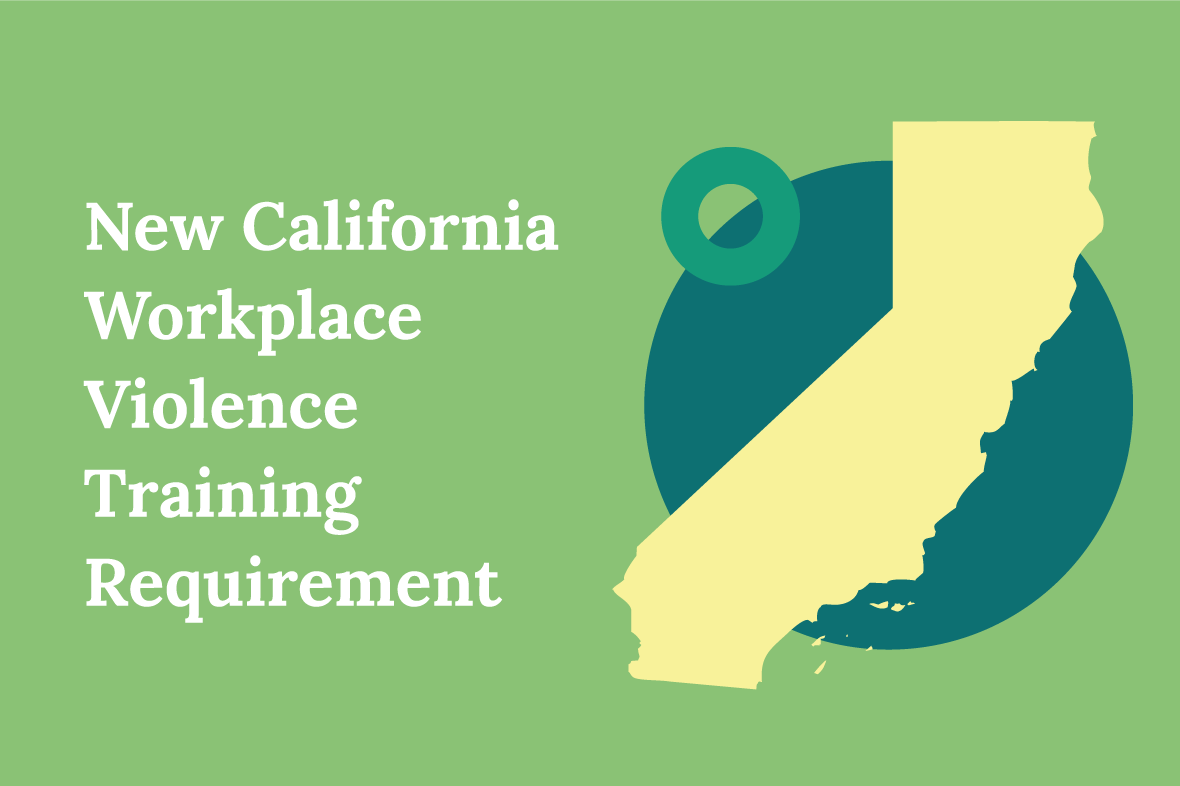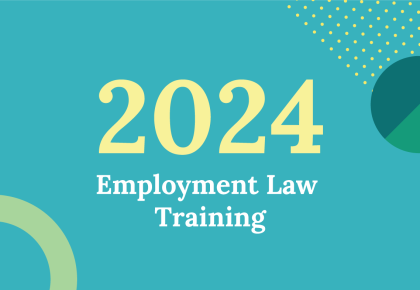New California Workplace Violence Training Requirement Goes into Effect in 2024
Is your organization ready to meet these new training requirements?
In September 2023, California Governor Gavin Newsom signed Senate Bill 553 into law, adding Section 6401.9 to the California Labor Code. The new Labor Code section requires employers to implement a workplace violence prevention plan and provide annual training on their plan. Section 6401.9 becomes effective on July 1, 2024, and employers would be wise to begin planning to implement a workplace violence prevention plan and train all employees on their plan as soon as possible.[1]
The new California law has sparked several questions, which is not surprising given the arduous requirements, the relatively short time to comply, and the ambiguity about an actual timeline for compliance with the training requirement. This article attempts to answer the frequently asked questions concerning this new law. Syntrio welcomes you to contact a member of our staff to discuss how our industry-leading California workplace violence prevention course complies with the new law and can be customized to suit the needs of your industry.
Frequently Asked Questions
- What is the effective date of the new law?
California Labor Code Section 6401.9(i) states that subdivisions (b) to (g) are “operative” ‘on and after’ July 1, 2024. Given that subsection (c) sets forth the requirements of the workplace violence prevention plan and subsection (e) sets forth the training obligation, it follows that employers have an obligation to establish a plan (and train on it) beginning July 1, 2024.
- When must the plan be in place (and when must training be complete)?
Subsection (c)(1)(A) requires employers to “establish, implement, and maintain an effective workplace violence prevention plan.” Subsection (e)(2) requires employers to provide training “when the plan is first established and annually after that. . .” The timing ambiguity comes from the fact that while both provisions are “operative” as of July 1, 2024, the law itself does not say when the plan must be in place, and therefore, it is unclear when the obligation to train is triggered.
For compliance, we recommend that employers educate covered workforce members by July 1, 2024, to remove the need for argument. Given that the obligation to train is annual, any clarity received can be implemented in training programs provided in 2025 and beyond.
- What employers are covered by the law?
Labor Code Section 6401.9 Subsection (b)(1) states: “This section applies to all employers, employees, places of employment, and employer-provided housing.” The law carves out specific exemptions in subsection (b)(2). Exempt employers and employees are limited to the following:
- Certain healthcare facilities;
- Certain law enforcement agencies;
- Remote employees (when location is not under the control of the employer) and
- Places of employment with fewer than ten employees working at any given time.
The law applies broadly, and most employers must formulate and implement a plan to prevent workplace violence. Also, it must provide training on the plan (as well as other elements required by the law).
- What are the required elements of the workplace violence prevention plan?
The law requires employers to “establish, implement, and maintain” an “effective” workplace violence prevention plan. The plan must include all of the following elements:
- Names (and titles) of person(s) responsible for implementing the plan;
- Procedures for employers (and employees) to:
- Actively involve employees in the review and development of the plan.;
- Accept and respond to reports of workplace violence.
- Communicate with employees on how to report incidents; conduct investigations; how employees will be informed of results and any corrective actions;
- Respond to “actual or potential” workplace violence emergencies;
- Identify workplace hazards;
- Create a procedure for post-incident response and investigation, and
- Allow employees the opportunity to review the effectiveness of the plan.
Many of the plan’s elements will contain information for employees related to existing workplace violence education programs (including Syntrio’s course on the topic). We highly recommend taking Syntrio’s workplace violence courseware as a refresher on these topics as your organization considers what to include in the written plan before you provide it to your workforce.
- What is a violent incident log?
Under SB 553, employers must “record information in a violent incident log” about every incident, response, and investigation performed under their workplace violence prevention plan. Information to be contained in the log must include:
- The date, location, and time of the incident;
- The type of workplace violence that occurred
- A detailed description of the incident;
- Classification of who committed the violence (by type as described in the law);
- Consequences of the incident:
- Information about the person completing the log.
The violent incident log must be maintained for a minimum of 5 years and must be made available to employees for free copying.
- What are the training obligations imposed on the employer?
Covered employers must provide annual training to employees both when the plan is first established and annually after that. Subsection (e)(2) shows the training requirements and states that training must include all of the following elements:
- The definitions and requirements of Labor Code Section 6401.9;
- The employer’s plan, including how to get a copy at no cost and how to participate in its development and implementation;
- The violent incident log and its required contents and procedure;
- How to report incidents to the employer without fear of retaliation;
- Workplace violence hazards specific to employees’ jobs;
There must be an opportunity for interactive questions with someone knowledgeable about the employer’s plan. New training must be provided if any new (or previously unrecognized) hazards are discovered (or when changes are made to the plan). This unique training can be limited to addressing the new danger or modifications to the plan.
- What records must be kept by the employer?
- Records of workplace violence hazard identification, evaluation, and correction must be created and maintained for at least five years.
- Training records must be created and maintained for one year and shall include:
- Training dates;
- Contents or a summary of the training session;
- Names and qualifications of persons conducting the training;
- Names and job titles of persons attending the training sessions.
- Violent incident logs shall be maintained for a minimum of five years.
- Records of workplace violence investigations shall be retained for at least five years.
- What is the penalty for non-compliance with Labor Code Section 6401.9?
The new law expressly provides for issuing a citation and civil penalties under Labor Code 6317 if employers fail to comply with this section. Under Section 6317, employers who are given a citation are allowed a “reasonable time” to reduce the alleged violation. So, while penalties are attached, those violating the new rules may get the opportunity to rectify their mistakes following an investigation and the issuance of a citation. Still, Syntrio recommends advance compliance as a matter of best practice.
- How is Syntrio addressing the new California law?
Syntrio has provided industry-leading workplace violence courseware for decades. As a leader in the space, we appreciate the efforts made by the California legislature to bring this practice to all employers as a matter of safety. Syntrio has crafted a course that meets the requirements of Labor Code Section 6401.9 and will be customizable to both the employer’s plan and the industry. As new developments and regulations occur, Syntrio will update its course as it does with all material. Because there is an annual training requirement, Syntrio will be regularly altering and upgrading this course to ensure it is current and fresh.
We welcome the opportunity to be your partner in committing to the safety of your workforce. Syntrio recommends contacting a member of our staff today to see how we can help you now and in the future by not only meeting the obligations of California law but also helping you protect the safety of your workforce, wherever they may be.
[1] The new Labor Code section does state that Cal/OSHA shall propose regulations implementing this law (and provide clarity as to its requirements) by December 31, 2025 (to be adopted by December 31, 2026), so there is some ambiguity as to when training must be completed, but given the law is effective July 1, 2024, Cal/OSHA certainly could enforce it at that time. Therefore, employers are encouraged to utilize the information in the law and partner with a provider on a workplace violence prevention education program before July 1, 2024, to ensure compliance.
Train Your Employees
Harassment and bullying threaten a respectful workplace, including the effects on targeted individuals, coworkers, the work environment, and the organization.
Contact Syntrio today to ensure your training needs are being met.



